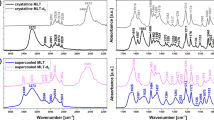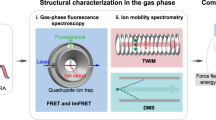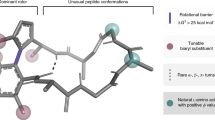Abstract
THE establishment of correlations between solid-state (for example, X-ray) conformations and conformations in solution (monitored by spectroscopic methods such as nuclear magnetic resonance (NMR)) is essential for the understanding of structure–function relationships in biologically active molecules. The relative functional importance of static and dynamic structures is of particular interest for peptide hormones which reach their site(s) of action on the receptor via a fluid medium. We describe here a comparative study of melanostatin (Pro–Leu–Gly–NH2) which acts as a melanocyte stimulating hormone release-inhibiting factor1.
This is a preview of subscription content, access via your institution
Access options
Subscribe to this journal
Receive 51 print issues and online access
$199.00 per year
only $3.90 per issue
Buy this article
- Purchase on Springer Link
- Instant access to full article PDF
Prices may be subject to local taxes which are calculated during checkout
Similar content being viewed by others
References
Nair, R. M. G., Kastin, A. J. & Schally, A. V. Biochem. biophys. Res. Commun. 43, 1376–1381 (1971).
Reed, L. L. & Johnson, P. L. J. Am. chem. Soc. 95, 7523–7524 (1973).
Ralston, E., De Coen, J. L. & Walter, R. Proc. natn. Acad. Sci. U.S.A. 71, 1142–1144 (1974).
Walter, R., Bernal, I. & Johnson, L. F. in Chemistry and Biology of Peptides (ed. Meinhofer, J.) 131–135 (Ann Arbor, Ann Arbor, Michigan, 1975).
Higashigima, T., Tasumi, M. & Miyazawa, T. FEBS Lett. 57, 175–178 (1975).
Deslauriers, R., Walter, R. & Smith, I. C. P. FEBS Lett. 37, 27–32 (1973).
Somorjai, R. L. & Deslauriers, R. J. Am. Chem. Soc. 98, 6460–6467 (1976).
Deslauriers, R., Ralston, E. & Somorjai, R. L. J. molec. Biol. (in the press).
Void, R. L., Waugh, J. S., Klein, M. P. & Phelps, D. E. J. chem. Phys. 55, 3604 (1971).
Noggle, J. L. & Schirmer, R. E. in The Nuclear Overhauser Effect—Chemical Applications (Academic, New York, 1971).
Quantum Chemistry Exchange Program 178, modified by W. M. Murphy.
Johnson, C. K., Oak Ridge National Laboratory Publication, ORNL-3794, Revised UC-4-Chemistry (1965).
Deslauriers, R., Smith, I. C. P. & Walter, R. J. biol. Chem. 249, 7006–7010 (1974).
Levy, G. & Nelson, G. L. Carbon-13 Nuclear Magnetic Resonance for Organic Chemists (Wiley-Interscience, New York, 1972).
Deslauriers, R. & Somorjai, R. L. J. Am. chem. Soc. 98, 1931–1939 (1976).
Flory, D. J., Statistical Mechanics of Chain Molecules 152 (Wiley-Interscience, New York, 1969).
Author information
Authors and Affiliations
Rights and permissions
About this article
Cite this article
DESLAURIERS, R., SOMORJAI, R. & RALSTON, E. Correlation between the X-ray structure of melanostatin and its conformation in solution. Nature 266, 746–748 (1977). https://doi.org/10.1038/266746a0
Received:
Accepted:
Issue Date:
DOI: https://doi.org/10.1038/266746a0
Comments
By submitting a comment you agree to abide by our Terms and Community Guidelines. If you find something abusive or that does not comply with our terms or guidelines please flag it as inappropriate.



